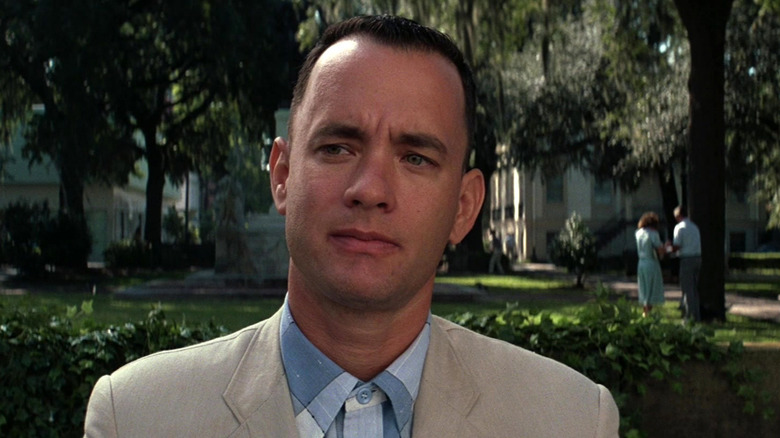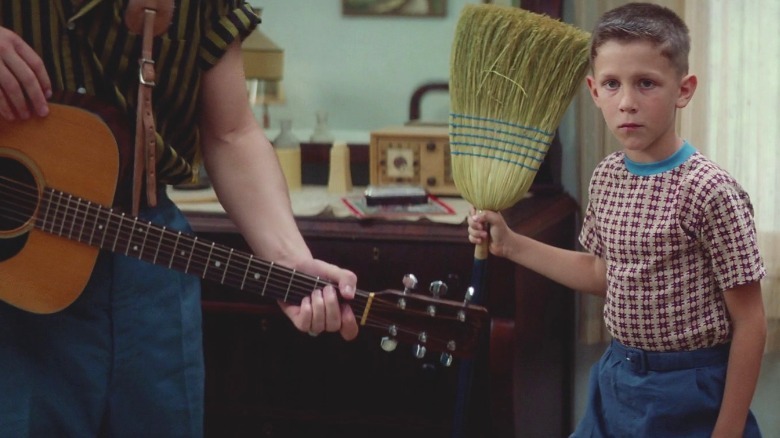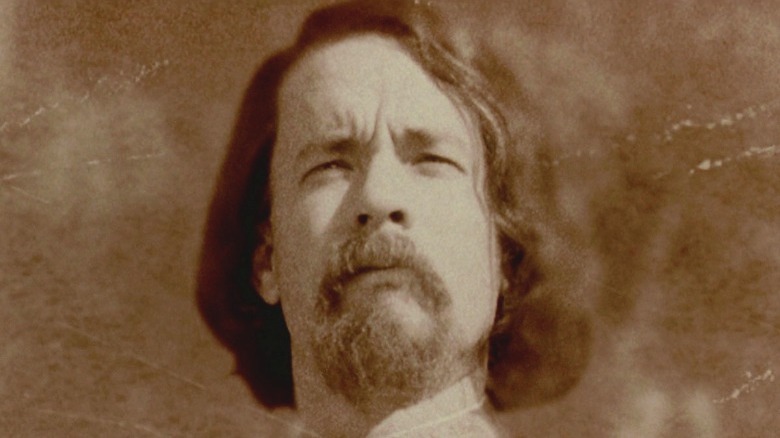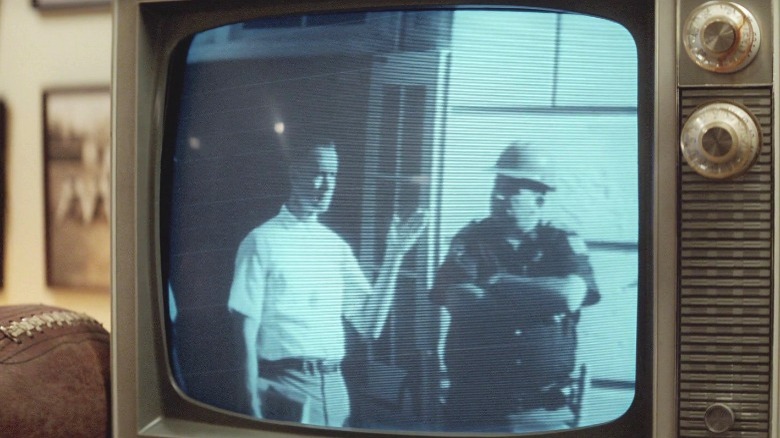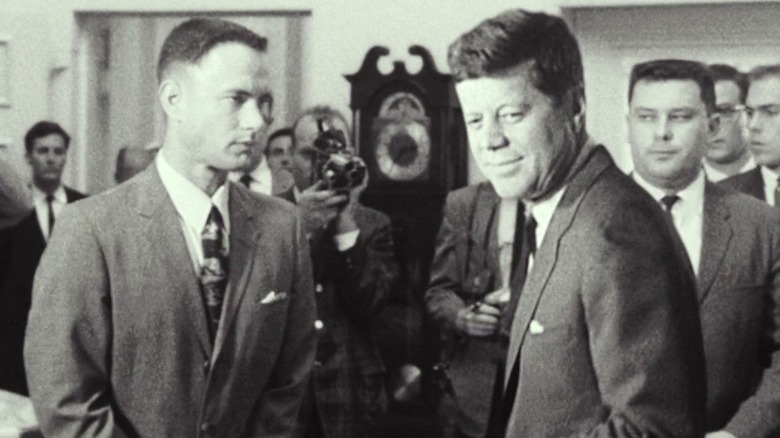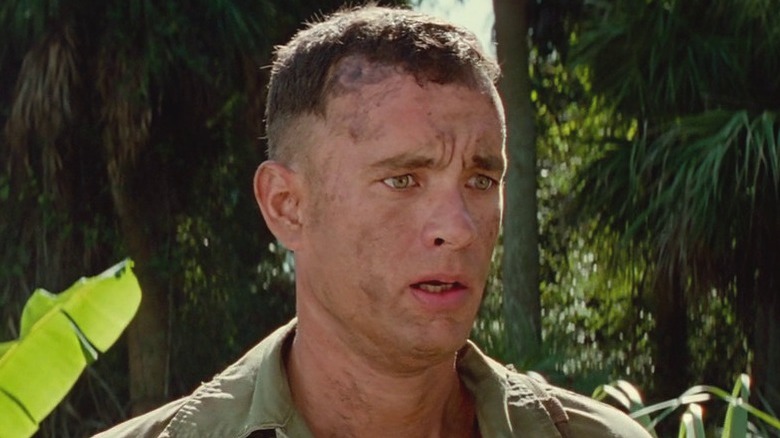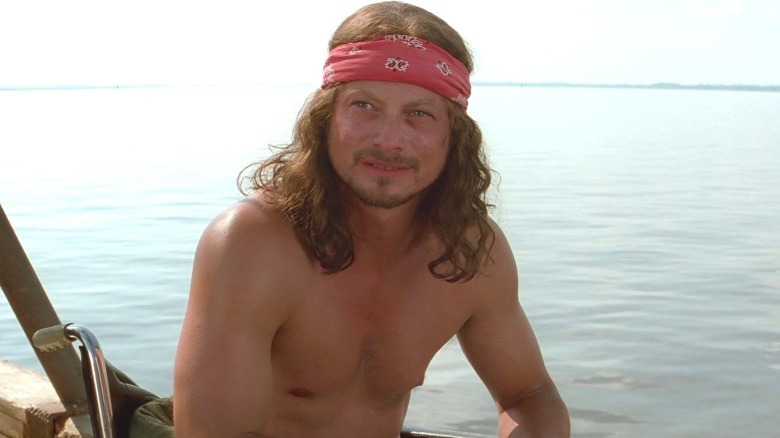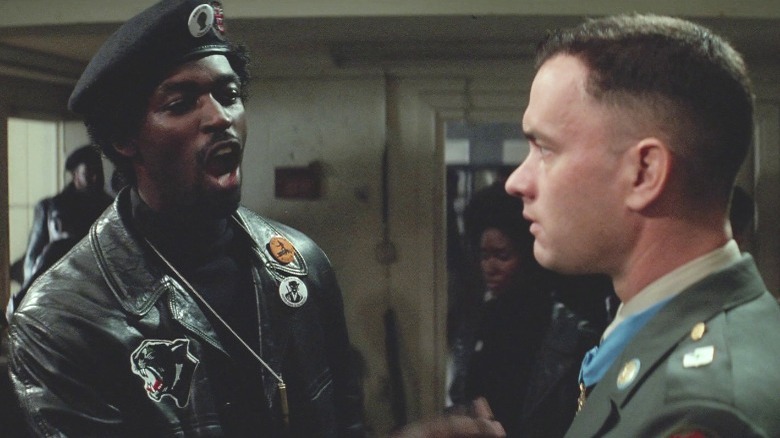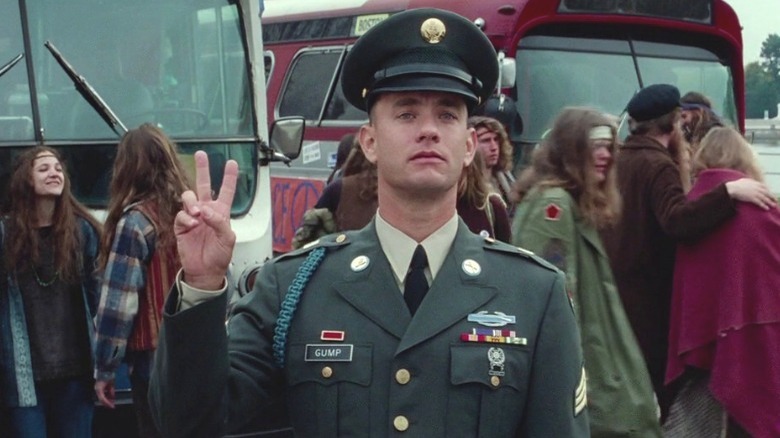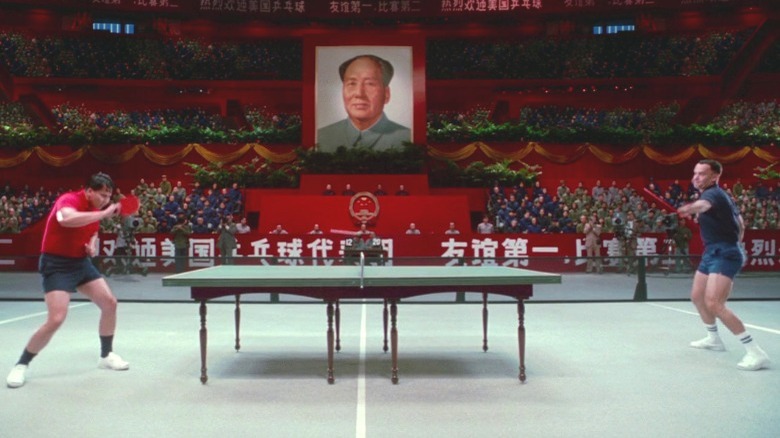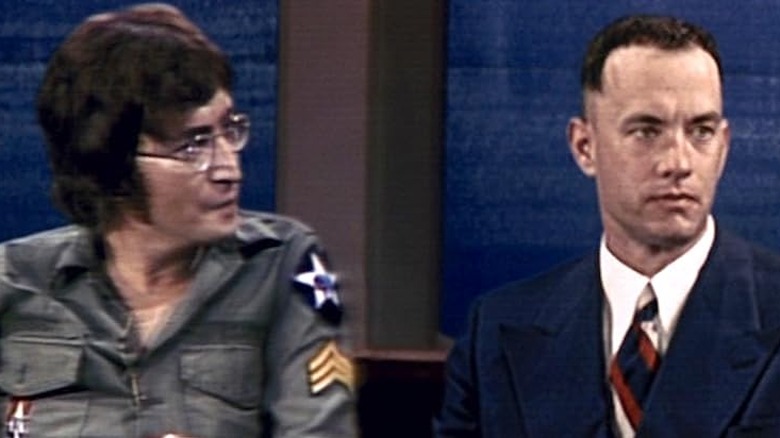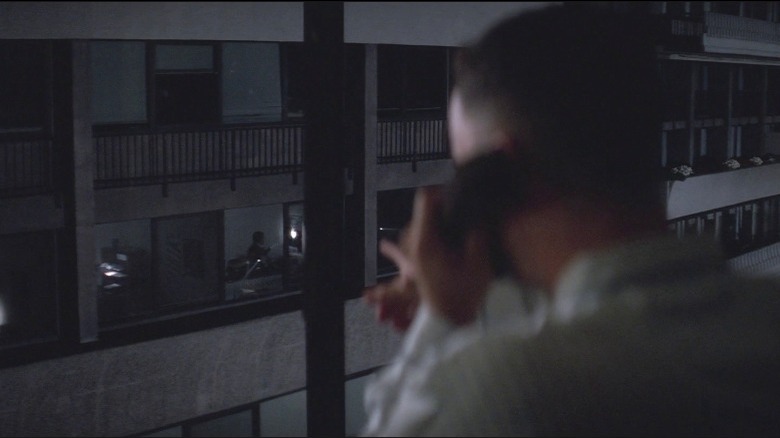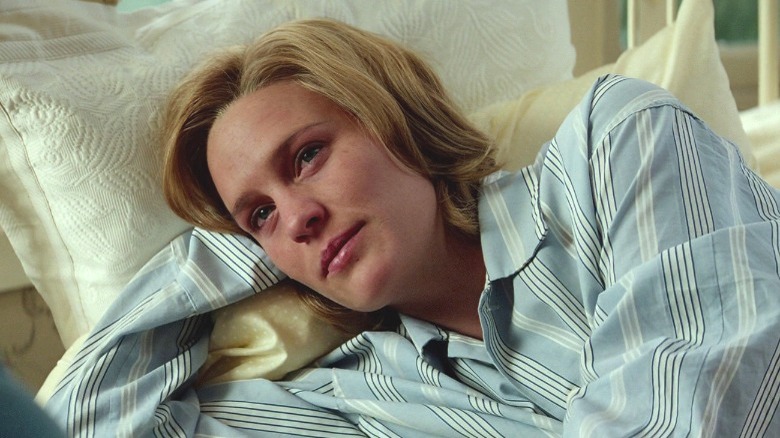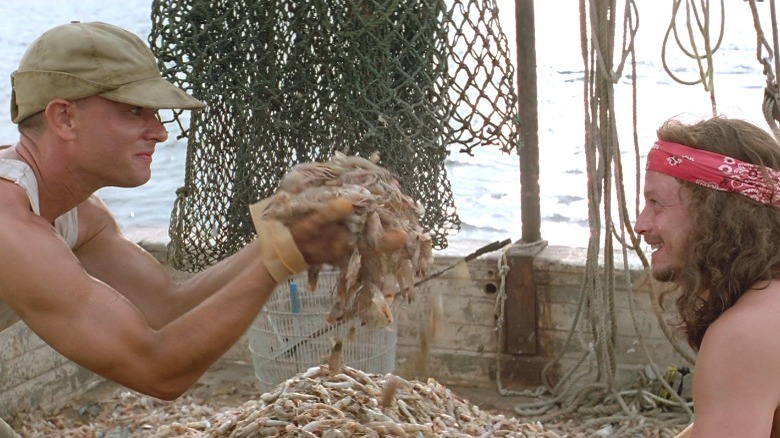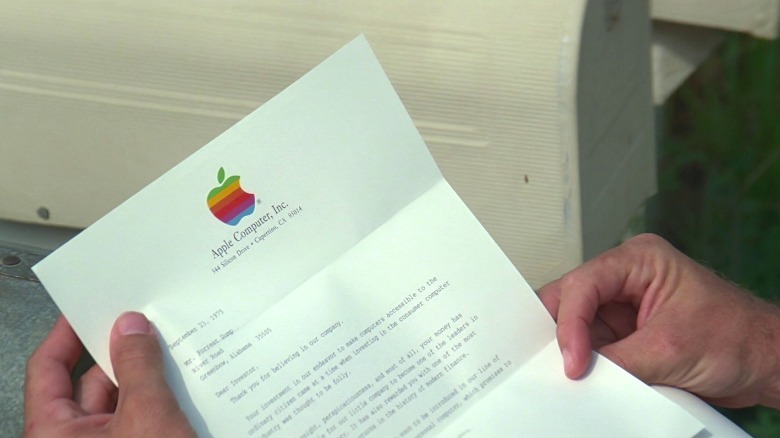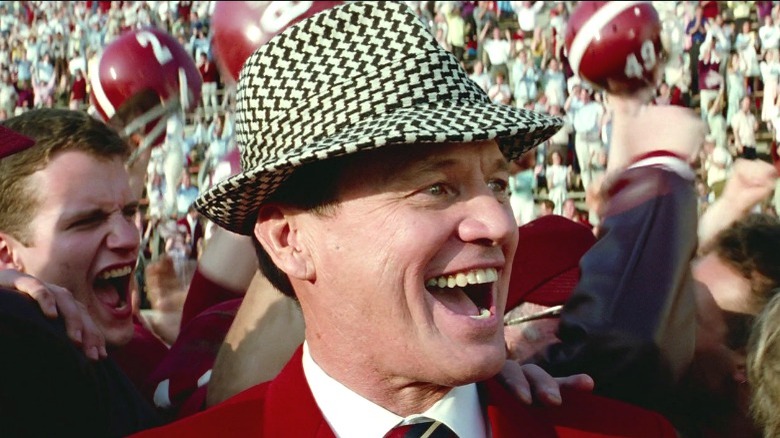The Best Historical References In Forrest Gump
Ever since it was released in 1994, "Forrest Gump" has been a popular and enduring movie. Boasting strong reviews and a plethora of awards, this sympathetic portrayal of the titular Alabama man, who's brought to life by Tom Hanks, has charmed countless moviegoers. One of the most memorable aspects of Forrest's story is his uncanny ability to find himself in the right place at the right time. This allows him to walk through some of the biggest events of the 20th century. While outlets like IndieWire have criticized this as presenting a whitewashed version of history, there's no doubt that Forrest's story has struck a chord with many fans as the years have flown by. As a straightforward person, he has a way of looking at American history that is as simple as it is profound.
Behind all the one-liners and feel-good moments, "Forrest Gump" is about what makes modern America the place it is today. From his introduction to a young Elvis Presley to his experiences in the Vietnam War, we're taking a look at the very best historical references in "Forrest Gump."
Elvis Presley's humble beginnings
One of the most memorable historical references in "Forrest Gump" is a seemingly minor interaction between Forrest and a young man staying at his mother's boarding house. Little Forrest is seen dancing while the man plays an acoustic guitar. The musician is fascinated by the way Forrest, who wears leg braces, moves his hips and legs. Later, when Forrest and his mother walk down the street, they see the man dancing in a similar fashion on a TV in a store window.
While younger viewers might not recognize him, the man is none other than the legendary Elvis Presley, the King of Rock and Roll. The song that Forrest is seen dancing to is an early version of "Hound Dog," one of the King's biggest hits. The hilarity of the scene is in its suggestion that Forrest's unorthodox dance movies were the inspiration for Elvis' infamous hip gyrations, which shocked audiences and led him to massive fame and fortune.
Nathaniel Bedford Forrest
Early in the movie, just after Forrest gets his leg braces, he shares the story of how he got his name. According to Forrest, he was named after Civil War general Nathaniel Bedford Forrest. Forrest describes this distant relation as a war hero ... and a founder of the Ku Klux Klan.
To say this moment hasn't aged well is an understatement. This is one of the most problematic historical references in the movie. While Forrest acknowledges Nathaniel's place in the KKK, this mention completely sanitizes the group's despicable history. No mention is made of their murderous terrorism — Forrest instead focuses on their wearing of white bedsheets, and simply says they rode around the countryside. Admittedly, the reference seeks to explore Forrest's complete ignorance of history and his deeply Southern upbringing, rather than give an accurate description of the group. Still, it stands out as a questionable — if memorable — reference.
Forrest stands in the schoolhouse doorway
Forrest's running skills get him a football scholarship to the University of Alabama in the early 1960s. While he's there, he ends up enmeshed in one of the most important moments in civil rights history: Alabama governor George Wallace's stand in the schoolhouse door. While outside school one day, Forrest notices a large commotion and asks what's going on. His fellow student responds with an ugly racist slur. Confused, Forrest watches as two Black students make their way into the school. When one of them drops her book, he retrieves it for her.
Forrest has no idea this is a landmark moment in desegregation. According to History.com, Wallace's infamous stand occurred when he refused to allow Black students Vivian Malone and James Hood into the university. He only relented when the National Guard forced the issue. Though this moment is incredibly complex, to Forrest, it's simple — his fellow student drops her book, and he helps her out.
Forrest and the presidents
Throughout "Forrest Gump," the titular character finds himself interacting with some of the most famous and important people of the 20th century. This includes several American presidents. After winning a spot on the All-American team during his time at the University of Alabama, Forrest meets President John F. Kennedy. Having drunk a staggering 15 Dr. Peppers, he meets the president and informs him, "I have to pee."
Later, after being awarded the Medal of Honor for his actions in Vietnam, Forrest meets President Lyndon B. Johnson. Much to the shock of his mother, he moons the president, to show him the bullet wound he got in his buttocks. After his war service concludes, Forrest meets President Richard Nixon. They have a brief conversation about the hotel — The Watergate, naturally — that Forrest is staying in. In addition to meeting several presidents, Forrest also mentions witnessing the assassination of President Kennedy, as well as the attempted assassinations of Presidents Ronald Reagan and Gerald Ford.
Forrest and the Vietnam War
The most extensive historical reference in "Forrest Gump" is the movie's portrayal of the Vietnam War. Forrest joins the army in the 1960s, just as the war is starting to heat up. There, he befriends Benjamin Buford "Bubba" Blue (Mykelti Williamson) and meets Lieutenant Dan Taylor (Gary Sinise). Forrest turns out to be a standout soldier who excels in taking direction and following orders to a T.
When he actually gets to Vietnam, Forrest experiences the harsh reality of the war. Bubba dies in his arms, he gets wounded, the foreign climate presents many trials, and surprise attacks are frequent. Through it all is the constant hunt for the Viet Cong. Forrest also works as a "tunnel rat," which, according to the National Museum of the U.S. Army, was one of the more dangerous jobs one could have in Vietnam.
Forrest fights for the 9th Infantry Division of the U.S. Army, which was active in Vietnam from 1966 to 1969. This means it's possible that Forrest could have potentially fought during the Tet Offensive, which was one of the bloodiest, deadliest, and most significant operations in the entire war.
The legacy of Lt. Dan
In addition to Forrest's experiences of fighting in Vietnam, "Forrest Gump" also shows another side of the war: the fate of Vietnam veterans. Immediately after returning stateside, Forrest heads out to see the sights. He finds himself in the midst of a Vietnam Veterans Against the War rally happening in Washington D.C. Forrest gives a brief speech, which is incomprehensible due to his microphone being unplugged. It's implied to be about the struggles veterans face.
Then there's Forrest's commander in Vietnam, Lieutenant Dan Taylor. Dan's story is a vivid commentary on the tribulations many veterans faced when they returned home from the war. Throughout the second half of the film, Lieutenant Dan finds himself struggling with alcoholism, as well as his battlefield injuries, which cost him both legs. He's very disillusioned about the government and American society at large, to the point of outright hopelessness. This is an all-too-real reflection of many Vietnam veterans' experiences. Happily, by the end of "Forrest Gump," Dan is able to overcome his struggles and find inner peace.
The Black Panther Party
After Forrest reunites with childhood friend and love interest Jenny Curran (Robin Wright) following his speech at the Vietnam veterans' rally, she brings him to a gathering that includes multiple members of the Black Panther Party. Forrest is wearing his full U.S. Army dress uniform when he enters the place, which immediately draws ire. While one of the Panthers lectures Forrest about his anti-war views, Forrest sees Jenny's boyfriend hit her. He attacks the man, which leads to him getting kicked out of the place.
According to History.com, the Black Panther Party was founded in the mid-1960s by Huey Newton and Bobby Seale. As PBS details, the group was indeed against the war: Black soldiers, in their view, were fighting and dying for a country that denied them basic protections and civil rights. All of this goes over Forrest's head, of course.
Abbie Hoffman and 1960s counterculture
Following Forrest's Vietnam service, he travels to Washington D.C. to receive the Medal of Honor from President Lyndon B. Johnson. When he gets there, he's swiftly corralled by leaders of the Vietnam Veterans' Against the War organization. Their protest is led by a man wearing an American flag shirt with wild and untamed hair. While many people might think he's just another hippie, he's actually Abbie Hoffman, a famous political activist and founder of the Youth International Party. As Encyclopedia Britannica explains, Hoffman was a prominent antiwar protestor with a particular penchant for theatrical stunts.
Jenny Curran is also present in this scene. Having dropped out of college, she's turned into a full-fledged hippie, spending her time traveling across California and experimenting with substances like LSD. She only briefly reunites with Forrest, quickly moving out of his life again to further protest the ongoing war. Jenny is the most vivid emblem of 1960s counterculture in the film, from her political beliefs to her nomadic ways.
Ping-pong diplomacy
While some historical references in "Forrest Gump" are pretty obvious, like the Vietnam War and Elvis Presley, some are more subtle. A reference to the "ping-pong diplomacy" of the Richard Nixon era is a great example. Forrest starts playing ping-pong while recovering in a Veterans Affairs hospital. He immediately excels at the sport, and is sent to the People's Republic of China to compete against Chinese players. Forrest vaguely hints that someone in a position of authority tells him this match is of geopolitical importance, but unless you lived through the 1970s, you probably have very little idea what he's talking about.
As strange as it may sound, Forrest's ping-pong playing is actually a significant historical event. In the spring of 1971, several American ping-pong players traveled to China at the invitation of Chairman Mao Zedong (per History.com). They played games against Chinese players, and were taken to Chinese cultural sites like the Great Wall and the Summer Palace. It was a significant thawing of U.S.-China relations, and led to Nixon visiting mainland China the next year.
Forrest meets John Lennon
One of the many important celebrities Forrest meets is legendary musician John Lennon, with whome he shares the stage for a television interview. Forrest talks about his experiences playing ping-pong in China, emphasizing the poverty he saw and the lack of church attendance. Lennon mulls these facts over, clearly in the throes of creating his iconic song, "Imagine." Lennon's eventual assassination by Mark David Chapman is also briefly referenced.
Lennon actually released "Imagine" in 1971, the same year he's supposedly interviewed alongside Forrest. At this point in his life, Lennon had left The Beatles and was performing as a solo artist. His assassination occurred in 1980, when he was just 40 years old. This unique scene is rooted in the actual interview that took place between Cavett and Lennon in late 1971. Though the movie came out in the 1990s, the visual effects used to superimpose Forrest upon the footage remain impressive.
Forrest discovers the Watergate break-in
When Forrest visits Washington D.C. at President Richard Nixon's invitation, he stays at the Watergate Hotel. There, he gets distracted by a bunch of men rummaging through another hotel room by flashlight. He surmises that they're innocently looking for a fuse box and calls the front desk in the hopes of alerting them to this issue.
This is a blatant reference to the infamous Watergate Scandal. As History.com explains, this infamous affair revealed that members of Nixon's reelection committee illegally broke into the headquarters of the Democratic National Committee. There, they attempted to swipe critical documents and wiretap phones. Nixon attempted to cover this crime up, but soon enough, the entire world knew what had happened at the Watergate Hotel. This scandal led to Nixon's resignation in 1974, and irrevocably soiled the legacy of his presidency.
The AIDS epidemic
Following years of separation, Forrest and Jenny finally reunite in Savannah, where Forrest meets her son. He soon learns that little Forrest Jr. is also his son. Jenny confides in Forrest that she's contracted a virus that has her doctors mystified. Forrest invites Jenny to stay with him so he can take care of her, and they soon get married. Unfortunately, the disease takes a major toll on Jenny, and she ends up passing away in her mid 30s.
Though it's never explicitly mentioned, Jenny's unknown illness is typically interpreted as AIDS. As History.com explains, HIV and AIDS came to widespread attention in the early 1980s. The virus was especially devastating to gay men, who were subjected to all kinds of harassment and discrimination, as well as the illness itself. Like Jenny, many people died from the disease before adequate treatments were invented. AIDS remains dangerous and widespread; as of 2019, it was responsible for nearly 1 million deaths each year.
Hurricane Carmen and Bubba Gump Shrimp
When Forrest Gump and his first mate Dan Taylor begin shrimping together, they struggle to turn a profit. Instead of finding delicious shrimp in their nets, they wind up with toilet seats, old army helmets, and license plates -– basically, anything except fish. It's not until a devastating storm hits and wipes out all of their competition that Forrest and Lieutenant Dan are able to become successful.
While you could be forgiven for thinking that the storm is just an invention, it's actually based on a real storm: Hurricane Carmen. According to the National Weather Service, Hurricane Carmen hit during the summer of 1974, affecting the Gulf of Mexico and the coast of Louisiana. Winds reached 110 miles per hour near the coast of Louisiana, and storm surges were over 11 feet high. The storm was devastating ... and provided a perfect fictional reason for Forrest and Lieutenant Dan to make it big.
Forrest the investor
Over the course of "Forrest Gump," Forrest finds himself involved with companies that go on to become some of the biggest in the world. The most obvious is Apple Computers, which Forrest describes as "some kind of fruit company." Lieutenant Dan Taylor invests in the company for Forrest, who becomes massively wealthy as Apple takes off.
Another hilarious reference is made to the iconic smiley face, made famous by Harvey Ball (per The Los Angeles Times). When Forrest runs across America, he becomes an inspiration to millions. One of them is a man who wants to put Forrest's face on a t-shirt. After getting covered with mud, Forrest dries his face on a blank yellow t-shirt, which leaves a perfect imprint of the now-famous smiley face.
Also referenced is the famous "S*** Happens" bumper sticker. As Forrest runs along, he accidentally steps in feces. Rather than be enraged, he simply says, "s*** happens." This inspires a man to turn the phrase into a bumper sticker, which appears on a truck — just as it gets t-boned in a car accident. Forrest probably doesn't see any money from this turn of phrase or the smiley face, but hey, he's got stock in Apple.
Playing football under Bear Bryant
While playing football at the University of Alabama, Forrest Gump becomes one of the best kick returners in the nation, winning All-American honors. He first comes to the attention of the Alabama staff after he outruns the entire team, inadvertently interrupting their practice. Seeing such great physical talent on display, the coach immediately recruits Forrest to the team.
This is a somewhat subtle reference many viewers might miss. The coach in question is the legendary Bear Bryant. He's instantly recognizable (to those in the know) thanks to his trademark houndstooth fedora. As Encyclopedia Britannica details, Bryant was a longtime coach for the University of Alabama: He won six national championships and ended his career with a whopping 323 victories. He's also known for producing several NFL-caliber quarterbacks, including Hall of Famers Joe Namath and Ken Stabler.
